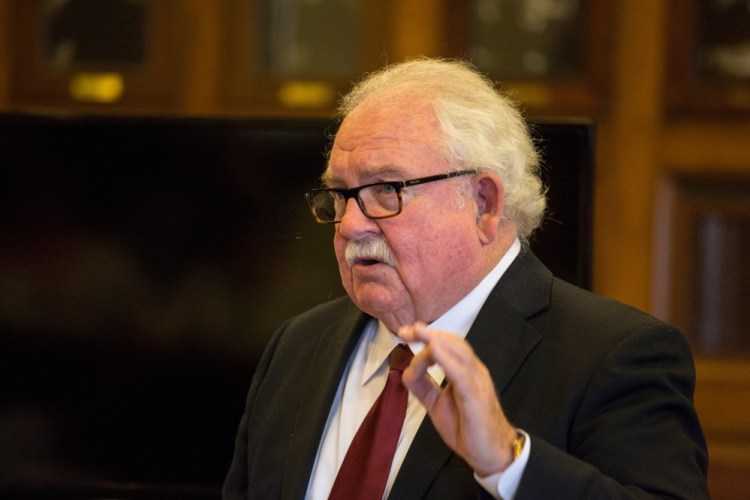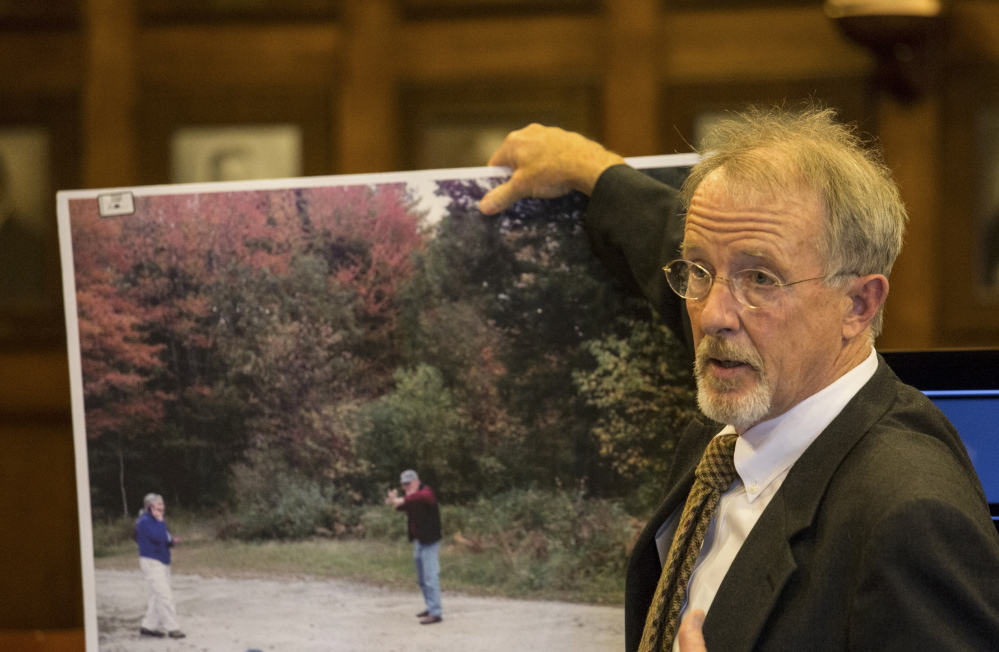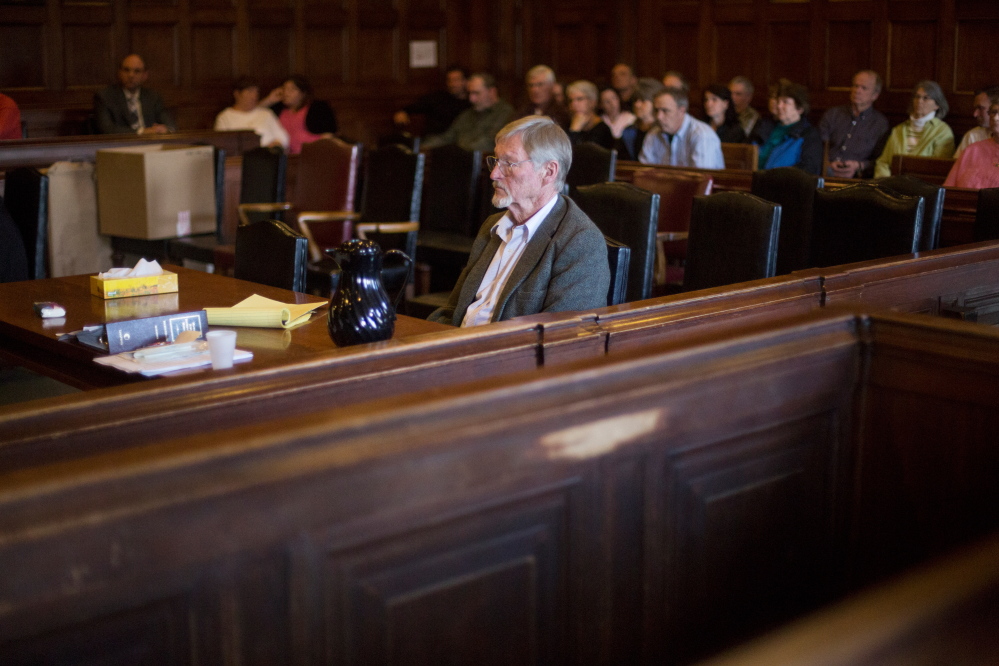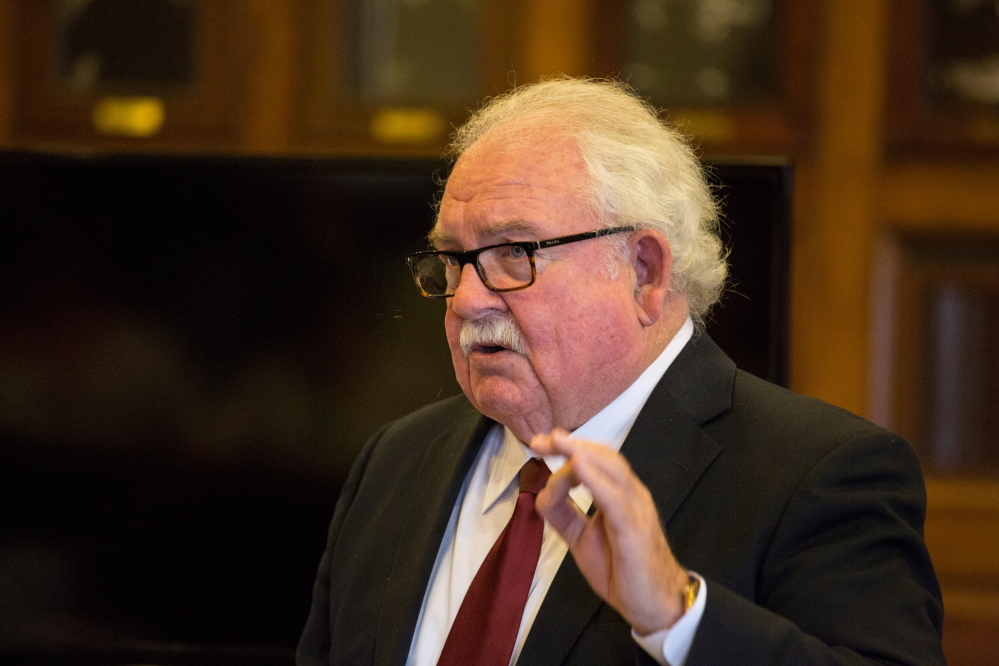Jurors deliberated for nearly three hours Tuesday in the murder trial of Merrill “Mike” Kimball without reaching a verdict. They will return Wednesday and try to decide whether Kimball was justified in shooting another man during a confrontation at a North Yarmouth bee farm in 2013.
Tuesday morning, lawyers on opposing sides presented the jury with starkly different versions of the events that led Kimball to shoot 63-year-old Leon Kelley on Oct. 6, 2013.
During closing arguments in the Cumberland County Courthouse in Portland, the prosecutor said Kimball intentionally took a concealed pistol and an extra clip of ammunition to Brown’s Bee Farm with his wife and stepson that day because he expected trouble from at least one member of Kelley’s family.
“He practiced with the gun. He knew where he was aiming. He knew what he was doing. He knew he was a good shot,” Assistant Attorney General John Alsop said during his closing arguments.
Kimball’s attorney portrayed Kelley as a “bully” who overwhelmed Kimball within moments after they met, attacking Kimball and using his size advantage to intimidate the older man.
“Mr. Kelley was walking deadly force,” defense lawyer Daniel Lilley said in his closing arguments. He said Kimball is licensed to carry a concealed gun and routinely kept it on his belt.
Both sides agreed, however, that the central issue before the jury of six men and six women is whether Kimball, 72, acted in self-defense as defined by state law.
“The defendant claimed he was justified in shooting down Leon Kelley, and it is up to you to decide whether the state has proved that no such legal justification exists,” Alsop told the jurors at the start of several hours of closing arguments.
JURY ASKS TO LISTEN AGAIN TO 911 CALL
The jury began its deliberations around 1:30 p.m. and broke for the evening around 4:15 p.m. The only insight into their deliberations came at midafternoon, when they sent a note to Justice Roland Cole asking to listen again to a recording of a 911 call made by Kelley’s wife in which the three gunshots can be heard.
“Oh my God, he just shot my husband,” Kathleen Kelley screamed about 35 seconds into that recorded call with 911 dispatcher Marcia Gilpatrick.
The jury is weighing six days of witness testimony from the trial that started April 6.
Testifying Monday as the trial’s final witness, Kimball’s wife, Karen Thurlow-Kimball, said she asked Kimball and her son to accompany her that day to the bee farm where she worked. Thurlow-Kimball wanted to retrieve about 700 pounds of honey that she had harvested.
Kelley’s stepson, Craig Rawnsley, had called Thurlow-Kimball about two hours before the 3 p.m. confrontation to challenge her job as the bee farm manager, they both testified.
The shooting at the bee farm off Greely Road followed an ongoing, bitter rift between the families over a business built up by 95-year-old Stan Brown, a master beekeeper well known in the state’s small beekeeping community.
Thurlow-Kimball had started working for Brown at the farm in 2009, and developed a close friendship with the older man, bonding with him over beekeeping. She testified that Brown’s family rarely took an interest in him until just weeks before the shooting, and that she had run Brown’s business for him as his dementia worsened, and cared for him in his family’s absence.
That relationship changed after Brown made Thurlow-Kimball a beneficiary in his will, leaving her the bee business. Brown’s daughters – including Kelley’s wife – and other members of the family were concerned that Thurlow-Kimball was taking advantage of their father as his memory began to fade.
WAS DEFENDANT ANGRY OR FEARFUL?
Alsop, the prosecutor, said in his closing argument that Kimball could have continued retreating from Kelley during the confrontation, but acted instead from anger when he drew his Ruger .380 pistol and fired three shots into Kelley’s torso.
“Bam. Bam. Bam. There was no pause. Merrill Kimball fired three rapid shots right in the middle of Leon Kelley,” Alsop said.
He re-enacted how Kelley could have fallen back after being shot.
“He’s twisted. He angles backward, and the shots kept coming,” the prosecutor said as he contorted his body.
Alsop explained that jurors could find Kimball guilty of murder or manslaughter, and outlined the state’s definition of self-defense to be considered for either charge.
The judge later gave the jury a detailed explanation of the state laws and a written copy of his legal instructions to bring into the jury room for reference.
For the jury to find that Kimball acted in self-defense, it would need to at least determine that a reasonable person in Kimball’s position would perceive that Kelley intended to cause him serious injury or death, that Kimball believed he faced serious injury or death, and that he could not retreat.
Lilley said that because Kelley was 6 feet 4 inches tall and weighed 285 pounds, he could have seriously injured Kimball, giving Kimball the legal authority to use deadly force to defend himself.
“They brought him along because he was mean and he was a badass,” Lilley said of Kelley. “They brought him along because he was big. He had a 3½-ton truck with the license plate ‘AWFUL.’ ”
MAKING ‘A SPLIT-SECOND DECISION’
Lilley replayed a recording of Rawnsley’s statement to police in which he said Kimball had “no other resort than the weapon” when faced with Kelley coming at him.
“People can be a dangerous weapon,” Lilley said. “They don’t match up a heavyweight with a lightweight, because a heavyweight could kill or seriously injure a lightweight.”
Lilley also urged jurors to try to imagine themselves in Kimball’s situation that day, faced with “a split-second decision.”
“Sometimes people in these situations might say, ‘He could have handled it differently.’ But that’s not the standard. You are not here to Monday-morning quarterback,” Lilley said.
Kimball was never arrested in the case and remained free on bail after being indicted on the murder charge in November 2013.
He faces 25 years to life in prison if convicted of murder. If convicted of manslaughter, he faces up to 30 years in prison. Kimball rejected a plea offer before the start of the trial. The terms of the offer have not been disclosed.
Scott Dolan can be contacted at 791-6304 or at:
Twitter: scottddolan
Send questions/comments to the editors.







Success. Please wait for the page to reload. If the page does not reload within 5 seconds, please refresh the page.
Enter your email and password to access comments.
Hi, to comment on stories you must . This profile is in addition to your subscription and website login.
Already have a commenting profile? .
Invalid username/password.
Please check your email to confirm and complete your registration.
Only subscribers are eligible to post comments. Please subscribe or login first for digital access. Here’s why.
Use the form below to reset your password. When you've submitted your account email, we will send an email with a reset code.